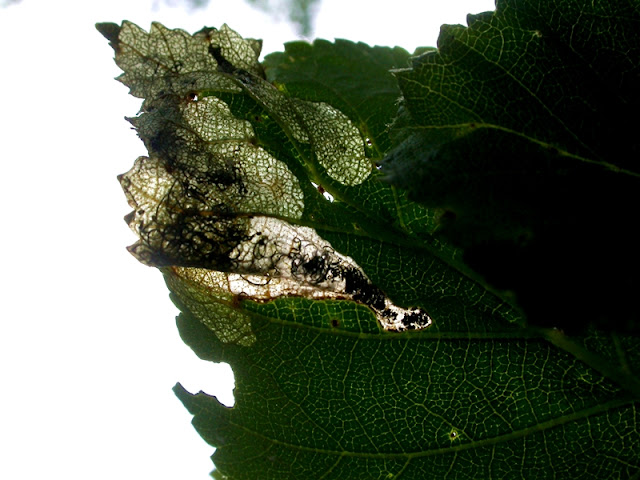My new-found interest in peering at leaves for larval feeding/pupating evidence has raised some good-hearted and playful derision from some....

I can take it..... especially when I keep adding new species to my list, some from photos as far back as 2010 which have sat in the 'to be identified' file until now. The two below are from this file.
The first is obviously an Eriocrania species and I identified it from the following points:
1/ The mine is on Birch.
2/ The mine starts towards the middle of the leaf and broadens out to the leaf margin.
3/ Long strands of frass.
4/ The mine is untenanted.
5/ The data of the vacated mine is early June.
This first three points combined would make it either Eriocrania salopiella or E. sparrmannella, and the last two points suggest it is the earlier of the two species, salopiella which mines May to early June, rather than sparrmannella which mines June to July. Both are scarce moths, indeed salopiella has a handful of VC63 records and no recent ones in VC62 and 64. Charlie Fletcher the CMR has commented "The earliest sparrmannella mine we have on the database is 18th June so I agree this is likely to be salopiella, however I think spring was early in 2012 so it's difficult to be certain.". I think I am going to have to find one with a larva in it....
 |
| 2.005 Eriocrania salopiella on Birch, Pilmoor, 4 Jun 2012 |
The next was almost overlooked as I was concentrating on the large blotch to the right which is Tischeria ekebladella while the small mine to the left of the mid-rib is Bucculatrix ulmella, taken at Pilmoor, 17 Oct 2010.
 |
| 14.010 Bucculatrix ulmella (left), 10.001 Tischeria ekebladella (right), Pilmoor, 17 Oct 2010 |
Moving away from lepidoptera another photo from the 4th June 2012 showed a birch leaf tightly rolled longitudinally which after a bit of investigation is likely to be the weevil known as the Birch Leaf Roller
Deporaus betulae.
 |
| Birch Leaf Roller Deporaus betulae |
Still two weeks of potential searching time left in 2017 whether it be on the few remaining leaves outside or scouring old photos for new moths!








